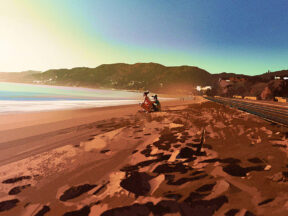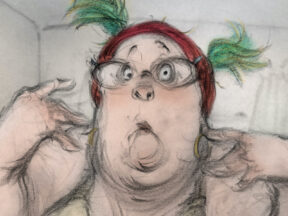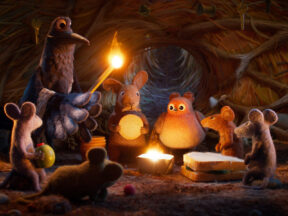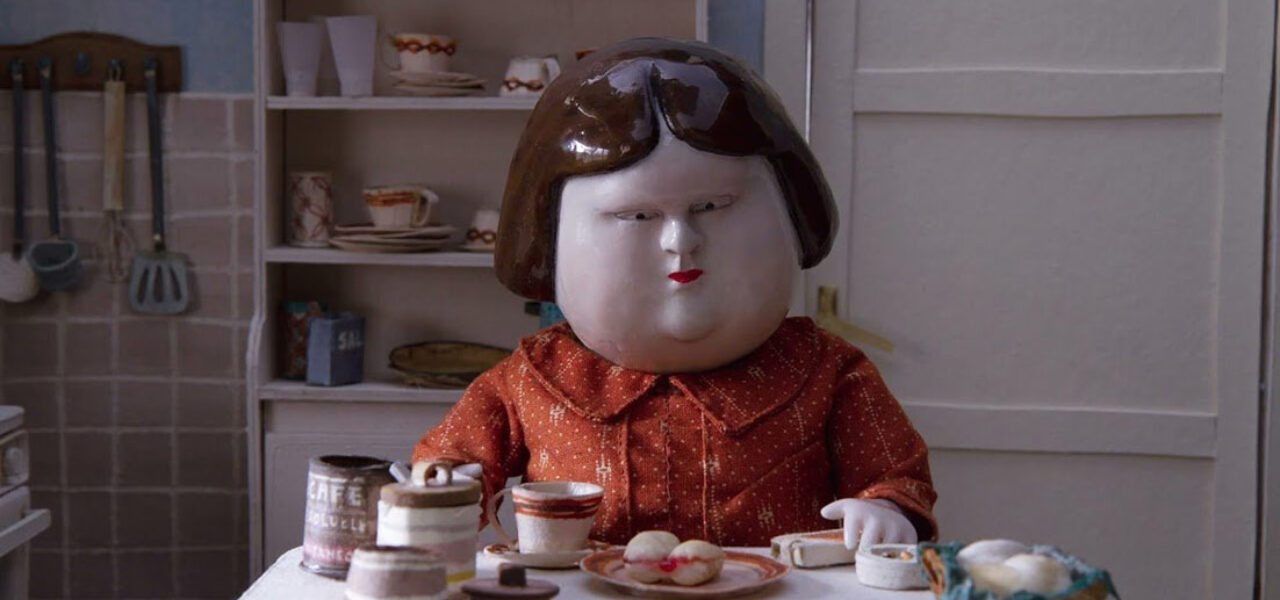
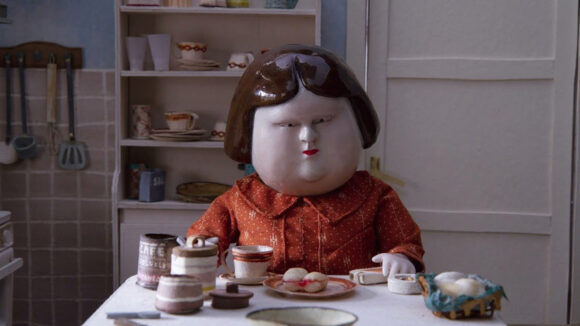
‘Bestia’: How A True-Life Story Of Torture And Evil Was Turned Into An Oscar-Nominated Stop-Motion Film
Self-taught Chilean animator Hugo Covarrubias has steadily honed his crafted with increasingly challenging projects for over 15 years. Now Bestia (Beast), an unsettling, stop-motion portrait of Ingrid Olderöck, has earned him and producer Tevo Díaz an Academy Award nomination for best animated short. Bestia, which premiered at Annecy in 2021, is also nominated at this year’s Annie Awards.
A singularly perverse member of the secret police during the country’s brutal dictatorship in the 1970s and ’80s, the real woman that served as source was tasked with torturing women using dogs. In turn her relationship with a particular canine becomes a cornerstone of this fictionalized take on the historical figure.
But long before the international acclaim for this manifestation of evil, Covarrubias entered the medium in 2006 with a stage show that blended live theater with stop-motion animation. Created alongside partner Muriel Miranda, the production was titled Maleza, and pursued some of the same dark psychological corners so present in Bestia.

“I had an idea to create a play that would have an important visual component and I thought it could be animation,” Covarrubias told Cartoon Brew. “But I had no idea how to do stop-motion animation, so I started researching. Back then the internet wasn’t what it is today, there wasn’t as much information, but I found some digital and physical books to learn about this technique.”
For its concoction of innovation and ingenuity, Maleza garnered significant attention among Chile’s artistic community, leading to further animation jobs for the burgeoning director. In those early years, Covarrubias directed two stop-motion literary adaptations of unnerving tales by Latin American authors: Feather Pillow based on the story by Horacio Quiroga and The Night Face Up from Julio Cortázar’s text.
Considering the tone of his work, it may seem evident that Covarrubias cites the macabre undercurrents in the oeuvre of Czech animation masters such as Jiří Trnka and Jan Švankmajer as a major influence. “I started to develop an aesthetic that centered on the darkness within human beings, and by aesthetic I mean both in the narrative and the visuals.”
In 2016, Covarrubias was a co-creator Paper Port, a tv series aimed at young audiences that blends stop motion and 2d animation. Around the same time Covarrubias connected with Díaz, a filmmaker from the documentary world who had often implemented animation in his work as a compelling storytelling device. Bestia is their first collaboration.
Following the first-ever Oscar win for Chile with the animated short Bear Story, the success of Bestia reaffirms a hope for a rapidly growing industry in the South American nation. Speaking via Zoom from Santiago, Covarrubias and Diaz walked us through the thematic labyrinth that their uncompromising short represents. The interview is accompanied by behind-the-scenes photos from the production of the film.

Carlos Aguilar: In this search for telling psychological complex stories with a layer of darkness, how did you land on the figure of Ingrid Olderöck as your chosen subject? Is her story particularly well known among Chileans?
Hugo Covarrubias: She wasn’t actually that well known before. Now thanks to the short film a lot of people know about her. A few years ago author Nancy Guzmán released a book titled Ingrid Olderöck, la mujer de los perros. She conducted a rather exhaustive investigation on Ingrid’s life. There were also other texts about her by Claudia Donoso and Alejandra Matus. Guzman and Donoso actually interviewed her. There was information about this figure, but it was still a bit obscure.
A few years ago we had an idea for a series about figures in Chile’s political history who were still not as famous. Another one of those figures was [Antonio] Ramón Ramón, one of the first anarchists in Chile who was actually from Spain. Among them was Ingrid Olderöck, who was mentioned in multiple stories and since she was a more contemporary character than the others we were considering, she captivated our attention. There is also a certain parallelism between her story and our current times. During production the most recent social uprising in Chile took place, and everything about this short made more sense.
So when the series didn’t pan out, you gravitated towards Ingrid to make a short film, from all the figures you had considered?
Tevo Díaz: The character of Ingrid is very interesting to tackle in stop motion, especially the relationship with her dog. Originally we were planning eight episodes of stop-motion animation, but with the limited funds we have in Chile we only had the opportunity to make this one short film.

Since you used historical evidence as foundation for your work, how much of her real-life story is in the finished product and how much is fiction?
Covarrubias: It’s a mostly fictionalized take. We decided to approach in a way that was slightly more cartoonish, particularly in her relationship with the dog. At first we find the dog adorable. Of course, the scenes where they eat together at the table are part of our fictional exaggeration of that relationship.
Díaz: The relationship with the dog is very interesting because it shows her quotidian life and her loneliness. The dog’s presence tells us about Ingrid as a character. Also, the dreams and the sequences that let us into her inner life are of course our interpretations of who Ingrid was.
Covarrubias: Animation let us into what happens in her head; it’s a medium that benefits those mental images. All of the surrealist and dreamlike elements that the short film explores exist because of the animation.
Society tends to associate violence with masculinity, but in Bestia we learn of what Ingrid was capable of. There are also scenes where she looks at herself in the mirror as if questioning who she is. Tell me about the significance of this identity crisis.
Covarrubias: We wanted to represent this woman as someone who isn’t sure about her place in society in relation to gender. This relates to the role that women had during the Holocaust, specifically the role that Nazi women had in juxtaposition to the Nazi men and to the Jewish women they murdered. Ingrid only tortured women, and she taught other women how to torture women. This creates a strange binary, because Ingrid in the end was almost like another man. Since she was a woman she was tasked with torturing women and instructing women, but what the women she tortured felt was that Ingrid was just like the men. We wanted to portray that inner conflict in the scenes where she tries to discover or recognize herself in her private life.
As she looks at herself in the mirror we imagine that she is asking herself, “Am I really a woman or am I only a woman when I’m in my room because outside I’m just another military person without gender in the eyes of society?” Of course a lot of this is open to interpretation, but these are the things we questioned about her. I can’t speak about feminism because I’m a man, but thinking about gender, I’m conscious that she is a woman, but she was carrying out evil acts that were genderless. So we imagine she perhaps used those intimate moments she had alone to reaffirm her identity as a woman.

Why did you decide to approach the story without dialogue, considering that in your previous work characters often speak?
Covarrubias: We made that decision given how much she could express with her body. We also wanted everything to be psychological and expressed through mental images only. At some point we considered using a narrator, but we decided not to approach it like a documentary, but to make a journey to the darkest corners of the human being’s mind. We did base our story on historical elements from the existing texts to give the film a historical foundation, but on top of that we built a fiction where we invented many places and situations that didn’t necessarily happen in reality.
Díaz: It was difficult because the figure of Ingrid is made of a resin that looks like porcelain and has fixed facial gestures. She only has six different expressions.

And what was the reasoning behind limiting her expressions from a practical and narrative perspective?
Covarrubias: We had one base or neutral expression for her, because we wanted the character to really have a single expression. People say that in real life Ingrid didn’t show much emotion with her face. Her expression was the same while walking down the street or when she was torturing people. It seemed logical for us to maintain that notion with this single facial expression for the doll.
The expression we selected was one that we felt could cause different reactions from the audience depending on the context, even if the face was the same. But we did have a few other faces to use when she is really frustrated, one that shows amazement, and a sad one for the period where she experiences sorrow, which is when one might empathize with her briefly, but that feeling rapidly vanishes. We created these additional expressions to enhance these feeling she had, which in the end weren’t all that real. That’s partly what we fictionalized. In reality she always had the same face, so when we show her being sad, that may have not happened in reality.

Hugo, can you elaborate on the design choices behind the figure of Ingrid and deciding to make her and the other human characters resemble porcelain?
Covarrubias: When we were first working on the series project, we had decided each of the episodes would have a distinct aesthetic. With the art director Constanza Wette we arrived at the conclusion that perhaps an aesthetic that resembled dolls and dollhouses could be pertinent to tell this story. When we decided to make the short film we kept some of those ideas, but I decided to clean it up and create contrast between backgrounds that were slightly more realistic and mundane, versus porcelain dolls that relate to Ingrid’s German ancestry. Her parents were Nazi Germans. Making her a porcelain doll was a reference to that past.
At the same time we wanted to show in a seemingly innocent way this doll as a kind of matryoshka with many layers, and for that the material was integral. The material also has a certain aesthetic and narrative qualities. For example, ceramic is cold, just as cold and as calculating as the character was for the acts she committed. It’s also rigid but fragile at the same time. If it falls it can easily break. That happens to Ingrid when they change her job. She becomes frustrated and suffers this attempted assassination that leaves a fracture in her mind, and that in turn reflects the fracture that dictatorship left in an entire country. The material itself becomes a narrator and is the spine of the short film.

What materials did you use in order to create figures with that finish?
Covarrubias: We used three types of resin: polyurethane resin as the base, crystal resin outside, which is like a coating, and inside it has expansive polyurethane resin so that it has volume but without weight. That way the interchangeable heads, easier to manipulate, are lighter and if they fall to the floor they won’t break.
Díaz: Chefs aren’t supposed to give away their recipe Hugo! [Laughs]
Covarrubias: One must be generous!
Bestia also features striking and even shocking imagery that make evil and a disturbed mind tangible. It’s fascinating what you achieved in the short in terms of the depiction of the human psyche. How did these provocative elements emerge?
Covarrubias: I had a lot of images in my head and we had to find the right moment to use them. There was a lot of philosophical work. It was like taking an essay about human evil and making it something visual with historical elements as the foundation. What we see are images from her fragmented mind, and the process was similar to that fragmentation. I would think of an image and then I attached it to another one to assemble the scenes.

Every scene showcases meticulous production design. There are details one might miss on first watch, but that make the world of Ingrid rich in its darkness. For example, there’s a brief instance where we get to see the Nazi relics she keeps.
Covarrubias: There was a significant amount of research involved. We even looked to more personal things like our own photo albums to see how the period looked, as well as archival footage. In the books about her there were also descriptions of the things Olderöck liked; among them was her affinity for the fascist imagery.
Ingrid’s dog is the film’s co-lead and his texture contrasts her rigidness. Can you explain the significance of this character and the process of bringing it to life?
Covarrubias: Matías Delgado was a key collaborator in animating the dog. He was the only other animator besides me. I knew that the dog had to contrast with the protagonist, especially at the beginning of the film. At some point Matías asked me if the dog could act tenderly and subtly, and I agreed. It had to be a docile dog, and not what you think of when you think of a tough police dog, even if it is a police dog. We were trying to confuse the viewer at the beginning in the sense that we introduce the story as if it were a run-of-the-mill tale about a woman and her dog. At first we know she teaches the dog things, but we are not sure what they are.
The viewer enters the story through this welcoming façade and eventually will realize what this dog is really being used for. I animated some of the harshest scenes, like the one about time passing where we see clearly what the dog does. The scenes where the dog behaves more benevolently or sweetly Matí animated them.
Besides studying how dogs move, there was a very complex shot as the dog walks alongside Ingrid. That shot provides a certain tranquility to the short and reflects their quotidian life and even some warmth. That was one of the shots that I consider taking out of the film because of how long it was taking us. Matías animated that shot and it took him about three weeks because it was very difficult to make the dog in such a subtle manner. Interestingly, as we were animated that short we got a visit from Paul Harrod, who is the production designer for Isle of Dogs.

Díaz: He was in Chile to attend Chilemonos, the country’s most important animation festival.
Covarrubias: He was impressed with the themes and with the quality of animation we were achieving considering our limited resources, which weren’t entirely precarious but definitely much lower than in the United States.
Díaz: His visit was crucial, because after seeing our work he gave us letters of recommendation that were able to use to apply for further government funding in Chile. That was critical for us to finish Bestia in post-production. Having a letter from Mr. Paul Harrod definitely helped us.

How would you describe the animation industry in Chile today in terms of resources and its potential for growth?
Díaz: In Chile we do have a sizeable audiovisual industry and for many years now there has been support from the government. There are public policies that pushed the industry forward, and within that industry there’s animation. We also have Animachi, which is a guild that brings together the country’s most important animation companies. In that sense we do have networks and connection with other countries. It’s obviously not like in the United States or in Europe, but we are growing. The fact that we are nominated is not an isolated incident. The animated short Bear Story won Chile’s first Oscar.

What was the timeline of production like and how did the real-world events of the last few years affect it?
Díaz: From the screenplay stage until the end it was about four years. The animation itself took about two-and-a-half years. And the post-production we did in record time because we had submitted the short to Annecy while still unfinished — it still had temp sound and you could still see the rigs behind the puppets. But when we got selected for Annecy, they told us, “You have to commit to deliver the finished film in two months.” That was madness. We had to finish the sound and the music in time. But we did it!
Covarrubias: It took that long because as we were making it as the social uprising of 2019 started, which was really an important moment for Chilean society. We couldn’t ignore that, and so the timeline of production was delayed. Not only did we join the protests, but also it was difficult to concentrate on the work with everything that was going on.
Díaz: Also, our studio was just a few blocks away from the epicenter of the protests.
Covarrubias: And then in early 2020, the pandemic began. I finished animating the short during the pandemic. I think some of the most important shots in the film were completed during the pandemic.

The short film is about the past, but do you feel that with the recent social uprising and through the short itself the younger generations in Chile can relate to its themes?
Covarrubias: It was tense because we were constantly getting information about people being tortured and what the police were doing to the protesters. We were making a short film about torture in the past, while this was happening again in our country. The social uprising made us remember these things. Now that Bestia is out there, some people in the younger generations are more aware, but there are still young people who don’t know about what happened in the past in Chile. This doesn’t mean they are right-winged, but they are simply misinformed and are perhaps worrying about other things that feel more immediate.
However, I’ve received a lot of messages from people saying, “Thank you for showing this.” But we have to thank the many journalists and researchers who showed these atrocities. We are making an artistic work based on all the information they uncovered. It’s great that through our short the information reaches the masses. The fact that we have been selected to so many festivals and that we are now nominated at the Oscars is so important in terms of visibility. It’s important to talk about the injustices and the justice that is needed, so that these events don’t repeat themselves and so that there’s no longer impunity for the perpetrators.

.png)
